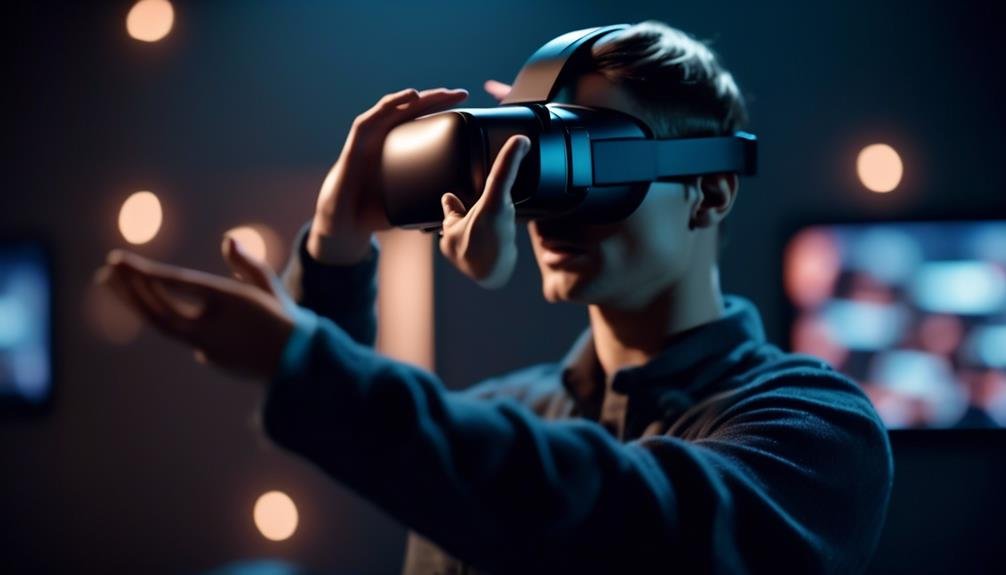Interactive Training Previews: a Sneak Peek Into Modern Learning Methods
In the ever-evolving landscape of education and professional development, the traditional methods of training and learning are being reshaped by the integration of interactive previews. This shift towards modern learning methods has sparked a considerable amount of interest and curiosity among educators, trainers, and learners alike.
The incorporation of interactivity in training previews has not only shown promise in enhancing engagement but has also paved the way for immersive and effective learning experiences.
As we explore the impact and potential of these modern learning methods, it becomes increasingly evident that interactive training previews may very well hold the key to revolutionizing the way knowledge is imparted and absorbed.
Key Takeaways
- Technology has revolutionized training previews, making them more interactive and immersive.
- Interactivity in learning enhances engagement, understanding, retention, and motivation.
- Active learner engagement and participation lead to better knowledge retention and application.
- Collaboration and participation foster critical thinking, problem-solving skills, and communication abilities.
Evolution of Training Previews
Throughout the years, the evolution of training previews has been instrumental in shaping the effectiveness of modern learning methods.
The traditional approach to training previews involved static presentations or written materials, often lacking in engagement and interactivity.
However, with the evolution of technology, training previews have undergone a significant transformation. The shift towards interactive and multimedia-rich previews has revolutionized the learning experience.
By incorporating elements such as simulations, gamified content, and virtual reality, training previews have become more immersive and engaging, leading to enhanced knowledge retention and application.
Moreover, the personalization of previews through adaptive learning algorithms has allowed for tailored content delivery, catering to individual learning styles and preferences.
This evolution has not only made previews more effective in preparing learners for the actual learning experience but has also increased motivation and engagement, resulting in improved learning outcomes.
As a result, the evolution of training previews has played a pivotal role in elevating the overall effectiveness of modern learning methods, setting the stage for a more dynamic and impactful learning experience.
Benefits of Interactivity in Learning
The benefits of interactivity in learning are manifold.
It engages learners actively, encouraging them to participate and collaborate with their peers.
This not only enhances knowledge retention but also creates an immersive and effective learning experience.
Engages Learners Actively
Engaging learners actively through interactive learning experiences fosters deeper understanding and retention of the material. Active participation and learner engagement are crucial in modern learning methods.
The benefits of engaging learners actively include:
- Improved Retention: Active participation keeps learners focused and helps them retain information better.
- Deeper Understanding: Interactive learning experiences encourage learners to think critically, ask questions, and apply the knowledge, leading to a deeper understanding of the subject matter.
- Enhanced Motivation: Actively engaging learners can boost their motivation and interest in the learning process, making it more enjoyable and effective.
Enhances Knowledge Retention
Enhancing knowledge retention through interactivity in learning builds upon the foundation of active learner engagement, leading to a more comprehensive grasp of the material and improved long-term memory retention.
Interactive assessments play a pivotal role in reinforcing knowledge by providing learners with immediate feedback, allowing them to identify and address areas of weakness.
By actively participating in the learning process, individuals are more likely to remember and apply the information effectively.
Furthermore, interactive training methods, such as simulations and scenario-based learning, immerse learners in real-world situations, making the learning experience more memorable and impactful.
This approach not only enhances knowledge retention but also fosters a deeper understanding of the subject matter, ultimately resulting in more proficient and confident learners.
Encourages Collaboration and Participation
Encouraging collaboration and participation in interactive learning environments fosters a dynamic and engaging educational experience for learners. This approach not only enhances knowledge retention but also promotes a deeper understanding of the subject matter through active engagement.
Collaborative learning and participatory activities have numerous benefits, such as:
- Enhanced Critical Thinking: By working together on projects or discussions, learners are exposed to different perspectives, which stimulates critical thinking and problem-solving skills.
- Improved Communication Skills: Engaging in group activities and discussions encourages learners to articulate their thoughts and ideas effectively, honing their communication skills.
- Increased Motivation: Participating in interactive and collaborative activities can boost learners' motivation and interest in the subject matter, leading to a more positive learning experience.
These benefits highlight the importance of fostering collaboration and participation in modern learning environments.
Immersive Learning Experiences
Immersive learning experiences allow learners to fully engage with the subject matter, creating a more impactful and memorable educational journey. Through the use of virtual reality (VR) and gamified learning, learners are transported into realistic and interactive environments that simulate real-world experiences. Virtual reality technology enables learners to explore and interact with 3D environments, providing a deeper understanding of complex concepts that might otherwise be challenging to grasp. This immersive approach enhances retention and understanding by allowing individuals to learn by doing, rather than simply observing or listening.
Gamified learning, on the other hand, incorporates game elements such as point scoring, competition, and rules of play into the learning process. This not only makes learning more enjoyable and engaging but also encourages active participation and motivation. By integrating challenges, rewards, and instant feedback, gamified learning creates an environment where learners are more likely to persist in their educational pursuits and retain the knowledge gained.
Leveraging Technology for Engagement
In the realm of modern learning, the use of technology has become a pivotal factor in engaging learners and enhancing their educational experiences.
Leveraging technology for engagement involves utilizing interactive tools and platforms to create immersive and dynamic learning environments.
Technology for Interaction
Utilizing cutting-edge technology to foster interaction and engagement has become an integral component of modern learning methods. By integrating technology into interactive learning, digital engagement is enhanced, leading to increased learner participation.
The following are key elements of technology for interaction:
- Virtual Reality (VR) and Augmented Reality (AR) Applications: Immersive experiences through VR and AR elevate engagement levels and provide practical learning scenarios.
- Interactive Learning Platforms: Utilizing interactive platforms with features such as gamification, quizzes, and simulations promotes active participation and knowledge retention.
- Social Learning Tools: Leveraging social media and collaborative tools facilitates peer interaction, discussion, and knowledge sharing, creating a dynamic learning environment.
These technological advancements not only enrich the learning experience but also cater to diverse learning styles, ultimately leading to more effective training outcomes.
Enhanced Engagement Tools
The integration of advanced technological tools has revolutionized the landscape of engagement in modern learning methods, providing a dynamic and interactive educational experience for learners. Two key components driving this revolution are gamification and interactive simulations. Gamification incorporates game elements, such as point scoring and competition, into the learning process, increasing motivation and engagement. On the other hand, interactive simulations allow learners to apply knowledge in realistic scenarios, promoting active participation and skill development. Both these tools not only enhance learner engagement but also foster critical thinking and decision-making skills.
| Enhanced Engagement Tools | Description | Benefits |
|---|---|---|
| Gamification | Incorporates game elements into learning | Increases motivation and engagement |
| Interactive Simulations | Allows application of knowledge in scenarios | Promotes active participation and skill development |
These tools are transforming traditional learning approaches and are essential in creating a more immersive and effective learning experience.
Interactive Training Tools and Techniques
Engaging learners through dynamic and immersive experiences is essential for effective interactive training. In today's modern learning landscape, interactive training tools and techniques play a pivotal role in creating an engaging and impactful learning environment. Two key methods that have gained prominence in interactive training are virtual simulations and gamified learning. These techniques provide learners with hands-on experiences and create a sense of immersion, making the learning process more interactive and enjoyable.
- Virtual Simulations:
Virtual simulations offer a realistic and interactive environment where learners can practice and apply their skills in a safe and controlled setting. This method allows learners to make decisions, solve problems, and learn from their mistakes in a risk-free virtual space.
- Gamified Learning:
Gamification involves incorporating game elements, such as points, badges, and leaderboards, into the learning process. By introducing competition, challenges, and rewards, gamified learning captures learners' attention and motivation, making the training experience more engaging and enjoyable.
- Augmented Reality (AR) and Virtual Reality (VR):
AR and VR technologies are revolutionizing interactive training by providing immersive experiences that simulate real-world scenarios. These technologies enable learners to interact with virtual objects and environments, enhancing their understanding and retention of complex concepts.
Implementing Interactive Previews in Education
Implementing interactive previews in education enhances students' engagement and comprehension through hands-on experiences and immersive learning techniques. Interactive simulations and virtual reality (VR) are revolutionizing the educational landscape by providing students with realistic, interactive environments to explore complex concepts. Through VR, students can engage in virtual field trips, explore historical settings, or even dissect digital organisms, offering a level of experiential learning that was previously unattainable.
Furthermore, gamified learning and interactive assessments are reshaping traditional educational practices. By integrating game elements into the learning process, educators can create a more engaging and enjoyable experience for students, fostering a deeper understanding of the material. Additionally, interactive assessments allow for real-time feedback, personalized learning paths, and a more comprehensive evaluation of students' progress. These methods not only enhance student motivation and participation but also provide educators with valuable insights into individual learning styles and areas for improvement.
As technology continues to advance, the incorporation of interactive previews in education promises to further revolutionize the learning experience, making it more immersive, effective, and enjoyable for students.
Conclusion
The evolution of training previews has led to immersive learning experiences, leveraging technology for engagement.
The benefits of interactivity in learning are evident in the use of interactive training tools and techniques.
Implementing interactive previews in education has revolutionized modern learning methods, creating a sneak peek into the future of education.







